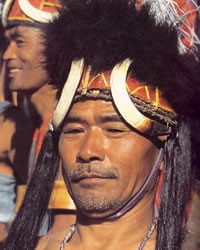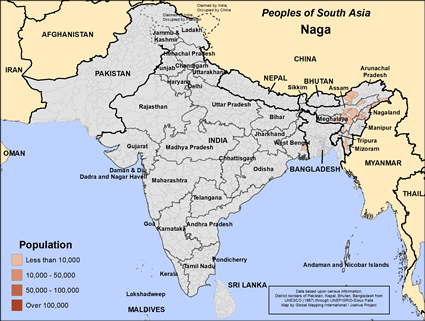Naga in India

Photo Source:
Anonymous
|

Map Source:
People Group data: Omid. Map geography: UNESCO / GMI. Map Design: Joshua Project
|
| People Name: | Naga |
| Country: | India |
| 10/40 Window: | Yes |
| Population: | 17,000 |
| World Population: | 17,000 |
| Primary Language: | Nagamese |
| Primary Religion: | Christianity |
| Christian Adherents: | 76.84 % |
| Evangelicals: | 0.00 % |
| Scripture: | New Testament |
| Ministry Resources: | Yes |
| Jesus Film: | Yes |
| Audio Recordings: | Yes |
| People Cluster: | South Asia Tribal - Naga |
| Affinity Bloc: | South Asian Peoples |
| Progress Level: |
|
Introduction / History
The Naga people come from Nagaland, a state in the extreme North East of India. It is believed that these hill-tribes of an Indo-Mongoloid stock have migrated from other countries of South-east Asia. There are 16 major tribes such as Angami, Ao, Chakhesang, Chang, Khemungan, Konyak, Lotha, Phom, Pochury, Rengma, Sangtam, Sema, Yimchunger and Zeliang.
Each tribe has their own language and cultural features. They communicate in Nagamese which is a mixture of Assamese, Bengali, and Hindi. Hindi also is used in Nagaland. English is the state language in Nagaland. They use the Roman script, which was introduced by American missionaries. The organization of each village community differs from tribe to tribe. Most of the tribes have a democratic structure called village councils but the Konyak tribe has a village chief called 'Ahngs'.
Weaving is a traditional art handed down through generations in Nagaland. Each of the major tribes has its own unique design and choice of colours. Warm and colourful Naga shawls, hand-woven shoulder bags, decorative spears, tablemats, wood carvings and bamboo works make magnificent souvenirs. Tattooing was common in Naga culture but now this practice is slowly decreasing. Agriculture is their main occupation and rice is their staple food. The Naga tribes are exogamous in matters concerning marriage. Marriage between the same clan is strictly prohibited.
The Naga villages are located atop hills and every village has a 'Morung' or a meeting house where weapons and prizes of war are stored. Tribal dances belonging to distinctive tribes form the major art form in Nagaland. Each tribe celebrates their own festival such as Sekrenyi, Moatsu, Tuluni, Aoling and Tokhu Emong.
The early Naga were worshippers of nature gods but the advent of Christianity in the late 19th century brought a total transformation among the people. The spread of Christianity, the growth of education and the development programs have rapidly changed the Naga culture. There are political problems between the state government and the National Socialist Council of Nagaland (NSCN) or the Naga under ground soldiers.
Prayer Points
For the salvation of the Naga people.
For the peace of Nagaland, for reconciliation between the factions and ease in political tensions.